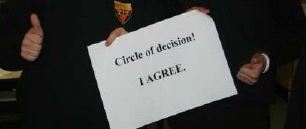-Circles of Decision
While teaching my more challenging BTEC science class about the intricacies of the atmosphere, I wanted to continue developing effective team work. I have recently been introducing a number of Kagan structures, which explicitly develop the collaborative skills students need to work effectively in groups, in to my lesson planning.
The students are capable of working in teams for short periods of time without swearing or hitting each other, and regularly do in activities such as ‘ask the expert’, but still struggle to communicate effectively for longer periods of time. In order to try to build these skills and reinforce their knowledge I have adapted a Kagan Circles of Decision lesson which worked extremely well.
Initially the students were split in to groups of three. The number is important for this activity. The Ninja Hamster grouping, which the class were familiar with, was used this time. This particular group structure is mixed ability with no obvious friendships. Before the lesson three hula hoops – agree, disagree and don’t know – were stuck on the ceiling. After students were introduced to these ‘Circles of Decision’ they were posed an openended question such as: “Plants are good for the atmosphere” and “Modern technology shall save the world from global warming”.
60 seconds were given to talk about the question after which time the three students in each group had to go to a different circle of decision, and be able to justify why they were standing in that opinion circle. A number of students were prompted to explain why they were standing in a particular circle and most could give a decent explanation. Where a student was struggling they were allowed to ask their group to help them out once, but they were encouraged to answer the question themselves the next time. This meant that the group had to discuss the question and understand how they could both agree and disagree with the statement and also be unsure about their opinion.
Some of the students displayed a fantastic degree of knowledge and understanding far beyond the scope of recent lessons. Everyone participated pretty equally during the discussions. During the lesson Paul Hopper and I were circulating round the groups and recording key words or sentences the students used in their discussion. We displayed these on the white board for discussion during the debrief. We then went through these statements with respect to the five R’s plus 1 and demonstrated to them the extremely high level they were working at.
They were also debriefed with respect to the level of thinking they used. They were impressed to identify they were employing some high level thinking throughout the session – Empathising with and defending positions they did not necessarily agree with, creating and evaluating arguments and frequently making links to prior understanding.
All in all an extremely successful lesson, which got students really thinking and talking about science, and considering more than one side of an argument. I am looking forward to using this again with different ability sets in the near future.
Steve Welsh
Inside-Outside Circle
Students stand in two circles – the inside circle faces out and the outside circle faces in. Every student has a partner, if there is an odd number, the spare student can ask questions then swap over half way through. The teacher (or spare student) should ask a review question then give the pairs an opportunity to discuss it. The teacher then selects a pair to answer.
Both partners need to know the answer, and if they don’t know they should consult with the pair on either side. This is a fast-paced activity in which all students are aware that, at any moment, they may be asked to share their learning with the rest of the class. It is, therefore, imperative that a safe environment is established within the group, so that all students feel confident speaking to their peers.
As you can see, a variety of styles of questions was asked. Though the same questions can be asked of every pair of students, it is possible to differentiate this activity by asking specific individuals to share certain answers, prompting them appropriately.
Consider having gentle music on in the background while they are discussing (like musical chairs) then when the music stops, the teacher asks a question. The students had fun and found the activity useful to review and reinforce new material. Add an element of speed-dating to this activity by rotating the inner, then the outer circle one place to the left after each question. This mixes up the pairs for every question, giving students access to a wide range of perceptions and levels of understanding.
Linda Rowe

